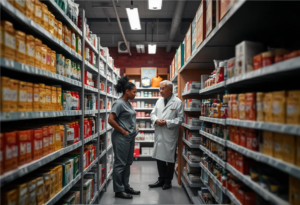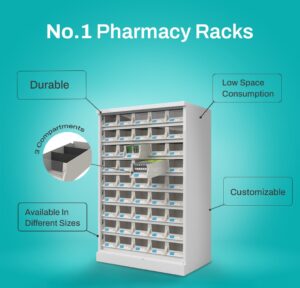Table of Contents
The pharmacy industry has long been a cornerstone of healthcare, bridging the gap between patients and essential medications. As healthcare needs continue to evolve, so does the pharmacy landscape. In recent years, advancements in healthcare technology, an aging population, and the surge in consumer health awareness have laid the groundwork for substantial growth in the pharmacy sector. By 2030, industry experts predict an unprecedented expansion, presenting tremendous opportunities for current and aspiring pharmacy entrepreneurs.
Understanding these trends and future projections is crucial for those looking to venture into the pharmacy business. This blog explores the anticipated growth in the pharmacy industry by 2030, focusing on urban and rural market expansions, shifting consumer purchasing trends, and the immense potential awaiting new entrepreneurs.
I. Projected Growth of the Pharmacy Industry
A. Overview of Expected Growth by 2030
By 2030, the pharmacy industry is poised to grow by an estimated 6-8% annually, driven by an increasing demand for accessible healthcare services and essential medicines. This steady growth will not only fuel the expansion of pharmacy services but also reinforce the sector’s role as a key player in the global healthcare landscape.
B. Factors Contributing to Growth
- Increasing Healthcare Needs: As chronic illnesses and lifestyle-related health conditions become more prevalent, the demand for medications and health-related services continues to rise. Pharmacies play a critical role in managing these conditions through prescription and over-the-counter medications, driving growth.
- Aging Population: The world’s aging population, particularly in urbanized regions, increases the need for continuous healthcare management. This demographic shift enhances the demand for specialized medications, geriatric care, and chronic disease management, further boosting the pharmacy industry.
- Technological Advancements: Innovations in pharmacy practices—like digital inventory management, telepharmacy services, and AI-driven patient consultations—enable pharmacies to operate more efficiently and offer diverse services. These technological advancements increase patient access to pharmaceutical care and help improve overall service delivery.
II. Rural vs. Urban Pharmacy Growth
A. Growth in Urban Areas
Urban areas are set to experience robust growth in the pharmacy sector by 2030. Factors driving this growth include:
- Trends in Urban Pharmacy Businesses: Urban pharmacies are evolving into healthcare hubs, offering an array of health services beyond medications, such as immunizations, health screenings, and wellness consultations. As urban consumers demand convenience, pharmacies that provide comprehensive services are likely to thrive.
- Increased Competition and Consumer Demand: Urban centers are highly competitive, with both large pharmacy chains and independent pharmacies vying to meet consumer demand. This competition stimulates continuous innovation in service offerings, customer engagement, and inventory diversification.
B. Growth Opportunities in Rural Areas
The potential for growth in rural areas is significant, as these regions often face challenges related to healthcare accessibility. By 2030, rural pharmacy growth may look like this:
- Overcoming Current Challenges: Rural pharmacies have historically struggled with issues like limited resources, fewer healthcare providers, and logistical challenges. Governmental support and private investment can help bridge these gaps, enabling rural pharmacies to expand and enhance their services.
- Expansion Predictions: Experts anticipate that rural pharmacies will increasingly adopt telemedicine and digital ordering systems to meet patient needs. This shift not only improves accessibility but also allows rural pharmacies to serve larger communities effectively.
Ill. Increasing Purchase Trends
A. Changing Consumer Behaviors
Consumer behavior in pharmacy purchases is shifting towards convenience and accessibility. Many patients now prefer one-stop healthcare experiences, driving demand for pharmacies that offer a mix of medication, wellness products, and essential health services.
B. Projected Rise in Product Purchases
Product purchases in pharmacies are expected to rise as health awareness grows. Prescription and over-the-counter medication sales are projected to increase by 10-12% by 2030, with wellness and preventive care products also seeing a significant boost.
C. Impact of E-commerce and Online Pharmacy Services
The rise of e-commerce has changed pharmacy purchasing habits, with online pharmacy services gaining popularity. By 2030, it’s estimated that a substantial percentage of consumers will use online platforms to order medications and health products, further expanding the reach and accessibility of pharmacies.
lV. Opportunities for Entrepreneurs in the Pharmacy Industry
A. Why Enter the Pharmacy Industry?
With predicted growth and ongoing innovations, the pharmacy industry offers vast opportunities for new business owners. An increasing demand for accessible healthcare solutions makes the sector promising for entrepreneurs.
B. Potential Business Models
New entrants can explore various pharmacy business models, such as:
- Independent Pharmacies: These offer personalized service and may become local health hubs in their communities.
- Online Pharmacies: Digital platforms cater to consumers seeking convenience, particularly in urban areas.
- Specialty Pharmacies: Catering to patients with complex health needs, these pharmacies focus on niche medication markets.
C. Key Considerations for Starting a Pharmacy
When venturing into the pharmacy business, it’s essential to consider factors like regulatory compliance, technological infrastructure, location, and staffing. Adapting to consumer demands and offering diverse services will be crucial to staying competitive in 2030.
V. Challenges and Considerations
A. Potential Obstacles
By 2030, pharmacies may face challenges such as supply chain issues, increased regulatory oversight, and heightened competition from online services. Adapting to these hurdles will be essential for business continuity.
B. Regulatory Changes
The pharmacy industry is closely regulated, and future changes could affect various aspects of operations, from medication handling to data privacy. Staying updated on regulatory shifts will be vital for pharmacy owners.
C. Strategies to Stay Competitive
To remain competitive, pharmacies should prioritize customer service, invest in digital transformation, and leverage data analytics to enhance patient care. By fostering trust and loyalty, pharmacies can establish themselves as essential healthcare providers in their communities.
VI. Conclusion
The pharmacy industry is set for a promising future, with projected growth driven by increasing healthcare needs, technological advancements, and consumer demand. For those considering a career or business in pharmacy, the outlook is bright. The growing importance of pharmacies in both urban and rural areas opens doors for entrepreneurs willing to innovate and adapt. Whether in bustling cities or remote areas, the pharmacy sector offers a pathway to success, combining profitability with the opportunity to make a positive impact on community health.
If you’re inspired by the promising future of the pharmacy industry and are ready to establish or expand your pharmacy, Allchemist is here to support your journey with state-of-the-art storage solutions. Our customized medical racks, cabinets, and pharmacy-specific storage options are designed to enhance efficiency, organization, and safety in your pharmacy setup. Whether you’re aiming to streamline your operations or ensure compliance with storage standards, Allchemist provides the expertise and products you need.
































